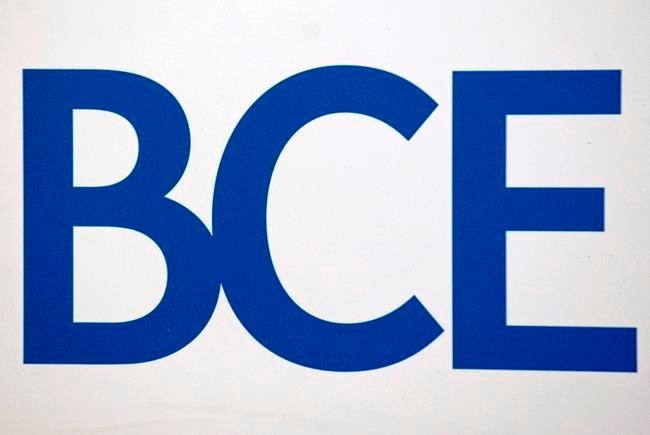TORONTO — BCE Inc.'s third-quarter profit was down 20 per cent compared with a year ago as its revenue also edged lower due to the COVID-19 pandemic's impact on its business and its customers.
However, the Montreal-based parent of Bell Canada showed improvement from the second quarter when economic activity across most of the country was slowed by the pandemic.
"Our focus in Q3 was all about building momentum back into the business. And although the effects of COVID are still obviously present, I'm very pleased with our progress to date," chief executive Mirko Bibic told analysts Thursday.
He said Bell experienced a notable improvement in operating performance due to the success of its expanded broadband communications network, the reopening of retail stores and the return of live sports programming.
Bibic said it's difficult to predict how the current fourth quarter will be affected by the pandemic but he thinks it will have positive momentum but less than in Q3.
Operating revenue totalled $5.79 billion, down 2.6 per cent from $5.94 billion a year ago. Compared with the second quarter ended June 30, Q3 operating revenue rose from $5.35 billion, which was down 9.1 per cent from 2019's Q2.
BCE attributed much of the revenue drop to the impact of COVID-19 on media advertising, wireless roaming volumes and reduced or delayed spending by business customers.
One of the biggest COVID impacts was a widespread drop in advertising, including at Bell Media — owner of the CTV national television network, the TSN sports channel, radio stations and newer forms of media.
"TV advertising demand picked up in several key categories, especially with the return of live sports and increased spending by advertisers," Bibic said.
Radio advertising and radio listenership has been slower to rebound while some locations for its out-of-home advertising space, such as airports, continue to suffer from the pandemic while outdoor billboards and street furniture ads improved.
However, Bell Media represents a relatively small component of BCE's overall revenue which is generated mostly by Bell Canada's large and diverse telecommunications business.
Bell increased its total subscriber base by 210,000 net new wireless, internet and IPTV customer activations in the three months ended Sept. 30 as it continued to expand its networks
"In Q3, we equipped 140,000 new locations with direct fibre (into the home), bringing the coverage level to 56 per cent of our total high-speed broadband footprint," Bibic said.
"We also announced a further acceleration in our wireless home internet build out that will approach 50 per cent of our target footprint by the end of the year, with the addition of another 80,000 homes in rural Canada."
Fibre-to-the-home enables faster internet speeds than most of Bell's cable rivals offer at this time and fixed wireless lets it serve small, remote markets underserved by landlines.
BCE's wireless business, which includes the Bell, Virgin Mobile and Lucky Mobile brands, had $2.32 billion of revenue — about the same as last year's third quarter.
The three brands added a total of 128,168 new postpaid and prepaid customers, compared with 204,067 in last years third quarter.
However, wireless service revenue was down 4.3 per cent to $1.59 billion, mainly due to a decline in roaming fees because of COVID's impact on travel as well as less in overage fees due to increased adoption of plans without monthly data ceilings.
Wireless product revenue, primarily smartphones, was up $11.9 million to $743 million — getting some extra lift from pent-up demand due to store closures in the second quarter.
Bibic said the rollout of its 5G wireless network and sale of 5G-equipped devices is still at an early stage but doing well.
"It's hard to tell," he said, adding that the end-of-year selling period that begins with Black Friday in late November will be more indicative of how 5G is adoption is going.
Looking ahead, BCE said government measures in response to a wave of new COVID cases in most of its markets, will likely slow down its positive momentum in the fourth quarter.
It maintained its quarterly dividend at 83.25 cents per share for the fourth quarter, which is five per cent higher than a year ago but unchanged since early 2020.
However, Bibic said BCE expects its capital spending to increase in the fourth quarter ending Dec. 31, in part because of ramped up inventory of smartphones and also network improvements.
The group earned a profit attributable to common shareholders of $692 million or 77 cents per share, down from $867 million or 96 cents per share a year earlier.
On an adjusted basis, BCE says it earned $712 million or 79 cents per share, down from an adjusted profit of $812 million or 91 cents per share in the third quarter of 2019.
Analysts on average had expected an adjusted profit of 77 cents per share and $5.71 billion in revenue, according to financial data firm Refinitiv.
This report by The Canadian Press was first published Nov. 5, 2020.
Companies in this story: (TSX:BCE)
David Paddon, The Canadian Press



